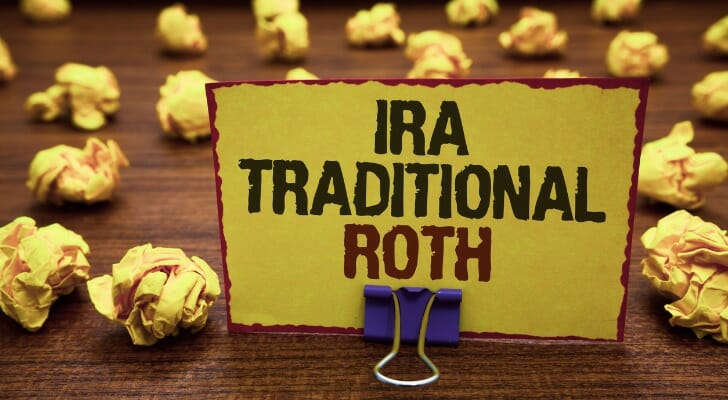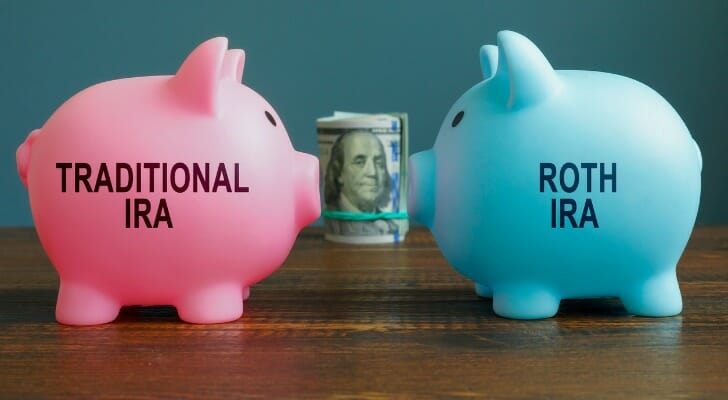One of the costs of converting a traditional IRA to a Roth IRA is how much you will pay in taxes. In some cases, those taxes can be a heavy burden, especially if you have been diligent in building up the balance in your traditional IRA. Fortunately there’s a way to put a lid on your tax liability as you convert to a Roth. Rather than converting the entire traditional IRA all at once, a series of partial conversions can minimize your taxes.
Consider working with a financial advisor for help handling your tax-advantaged retirement accounts. Speak with an advisor who serves your area today.
Roth Conversion Basics
There are two key reasons to convert a traditional IRA to a Roth IRA. One is that you can withdraw money later tax free, and second is that there are no required minimum distributions. Remember that early withdrawals (before age 59 ½) from a traditional IRA are subject to a 10% penalty. When you convert from a traditional IRA to a Roth you’ll want to make sure you do so in a way that doesn’t trigger the penalty. You have 60 days to convert if you move the money. It’s generally safer to let your brokerage(s) handle the conversion so you don’t forget to make the 60-day deadline.
Keep in mind that money in your traditional IRA has yet to be taxed. The point of a Roth IRA is that it’s already taxed money that grows tax-free. So, to convert your traditional IRA to a Roth IRA you’ll have to pay ordinary income taxes on the amount converted in the year of the conversion before they “count” as Roth IRA funds. The taxable amount that you convert to a Roth gets added to your taxable income for that year and is taxed at the appropriate rate.
Doing Partial Roth Conversions

Just as dollar-cost averaging helps ensure that you’re not buying high and selling low, doing a series of partial Roth conversions can help put a lid on what you will owe the government in taxes, according to Morningstar. The point is to convert just enough each year to keep you from being bumped up into a higher tax bracket.
For example, in 2025 a married couple filing jointly earning up to $211,400 would top out at the 22% tax bracket. But this couple’s top rate would then jump to 24% if their total taxable income was between $211,400 and $403,550.
Now, suppose they have taxable income of $125,000. In this case, they’d pay 10%, 12% and 22% tax rates on the different parts of their income that correlate to each of those federal brackets. This would then result in a total federal income tax of $10,640 (assuming they take the standard deduction).
If they convert a traditional IRA with a $115,000 balance to a Roth, that would result in their taxable income rising from $125,000 to $240,000. This then puts their top rate in the 24% marginal tax bracket, raising their total income tax to $35,140.
Now, however, suppose they decide on a partial Roth conversion. Rather than convert the entire $115,000 traditional IRA balance to a Roth, they only convert $50,000. That puts their taxable income at $175,000, keeping their top marginal rate at 22%. In this scenario, their total income tax for 2026 would fall to $20,840—significantly less than the $35,140 they would have owed if they had converted the entire balance into a Roth.
Note that these calculations are highly simplified and may not represent the scenario for all applicable situations. You may want to consult with your accountant or financial advisor when making tax decisions such as these.
Considerations of Partial Conversions
Clearly, partial conversions of traditional IRAs to Roth IRAs, done correctly, enable you to avoid unnecessary federal taxes. But besides this obvious benefit, there are some challenges that should be factored into your decision to do a partial conversion.
For example, what are the relevant state taxes? If you’re moving into a state that has a higher tax rate you’ll need to take that into consideration as you calculate how much of your traditional IRA to convert. Secondly, what will you earn in a calendar year? That can be hard to predict, especially if your compensation depends on commissions or if you stand to receive a bonus or exercise an incentive stock option.
Finally, keep in mind that extra income from a Roth conversion can result in you losing the subsidy you are entitled to as part of the Affordable Care Act.
When Can a Partial Roth Conversion Make Sense for You
A partial Roth conversion can be most useful during years when your taxable income is relatively low. For example, if you retire early and have not yet started taking Social Security or pension benefits, you may be in a lower tax bracket than you will be later. Converting part of a traditional IRA during this window allows you to pay taxes at today’s lower rates and reduce the burden once required minimum distributions begin.
It can also make sense if you expect your tax rate to rise in the future. This could be because of legislative changes, higher future earnings, or additional income sources in retirement. By converting gradually, you spread out the tax impact and avoid being pushed into a higher bracket all at once.
Estate planning is another factor. Heirs who inherit traditional IRAs must pay taxes on distributions, often under compressed timeframes. Partial conversions during your lifetime shift that tax burden away from your beneficiaries and can make the eventual transfer of wealth more efficient.
Finally, market downturns can create favorable opportunities for partial conversions. If your account value declines, converting at that lower value reduces the amount of taxable income created. When markets recover, the growth occurs inside the Roth, where it can later be withdrawn tax free.
Bottom Line

The primary reason to consider partial Roth conversions is to control future tax liability. You do this by “filling up” your lowest tax bracket to cap your taxable income at the maximum level of your existing tax bracket. This is sometimes called tax bracket arbitrage, paying taxes now at a lower rate than you otherwise would have to do at a future date.
Retirement Tips
- Handling your tax-advantaged accounts in a tax-savvy manner can be a challenge. That’s where the expertise and guidance of a financial advisor can be valuable. Finding a financial advisor doesn’t have to be hard. SmartAsset’s free tool matches you with vetted financial advisors who serve your area, and you can have a free introductory call with your advisor matches to decide which one you feel is right for you. If you’re ready to find an advisor who can help you achieve your financial goals, get started now.
- Use SmartAsset’s retirement calculator to gauge how you’re doing in preparing for retirement. If you’re thinking of converting to a Roth? These charts show how traditional IRAs and Roth IRAs stack up against each other.
Photo credit: ©iStock.com/designer491, ©iStock.com/Artur, ©iStock.com/kali9
